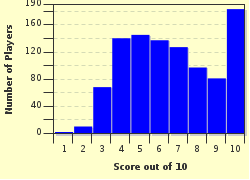Quiz Answer Key and Fun Facts
1. Using a bee as her messenger, a dryad of Greek myth told Rhoecus of her love. What was the reason for this love?
2. Which alcoholic drink, which is made from honey, has been referred to as the nectar of the gods and features in such tales as Fiolnir's death in Norse mythology?
3. Even the powers of certain Olympians can be traced back to the humble bee. Apollo was endowed with his gift of prophecy from three "bee-goddesses". By what name were these sisters known?
4. One of the most sacred insects in Egyptian mythology, the bee was closely linked with the sun god, Re. From what part of Re were bees supposed to have been born?
5. Which Greek goddess, known for her passion and beauty, was worshiped at a honey-comb shaped shrine at Mount Eryx by her priestesses?
6. Working so hard to make their honey, the bees originally had no weapons to deter thieves. They were therefore given stings by the merciful god, Wesakechak. Which mythology tells us this tale?
7. Bees are often depicted in mythology as having close links with humans. What odd tradition did some have, which reflected the belief that bees were symbols of domestic peace?
8. One Australian Aboriginal tale tells us of how a hard-working tribe of men, who stored food so as not to starve in the harsher months, were turned to bees. What were the second, lazy tribe transformed into?
9. Southern African mythology tells us of how a bee created the first man. What other insect is often featured in this tale?
10. Melissa, meaning "honey-bee", was a character of Greek myth who was said to have raised Zeus, nursing him with milk and honey. On which island did this take place?
Source: Author
doublemm
This quiz was reviewed by FunTrivia editor
CellarDoor before going online.
Any errors found in FunTrivia content are routinely corrected through our feedback system.

